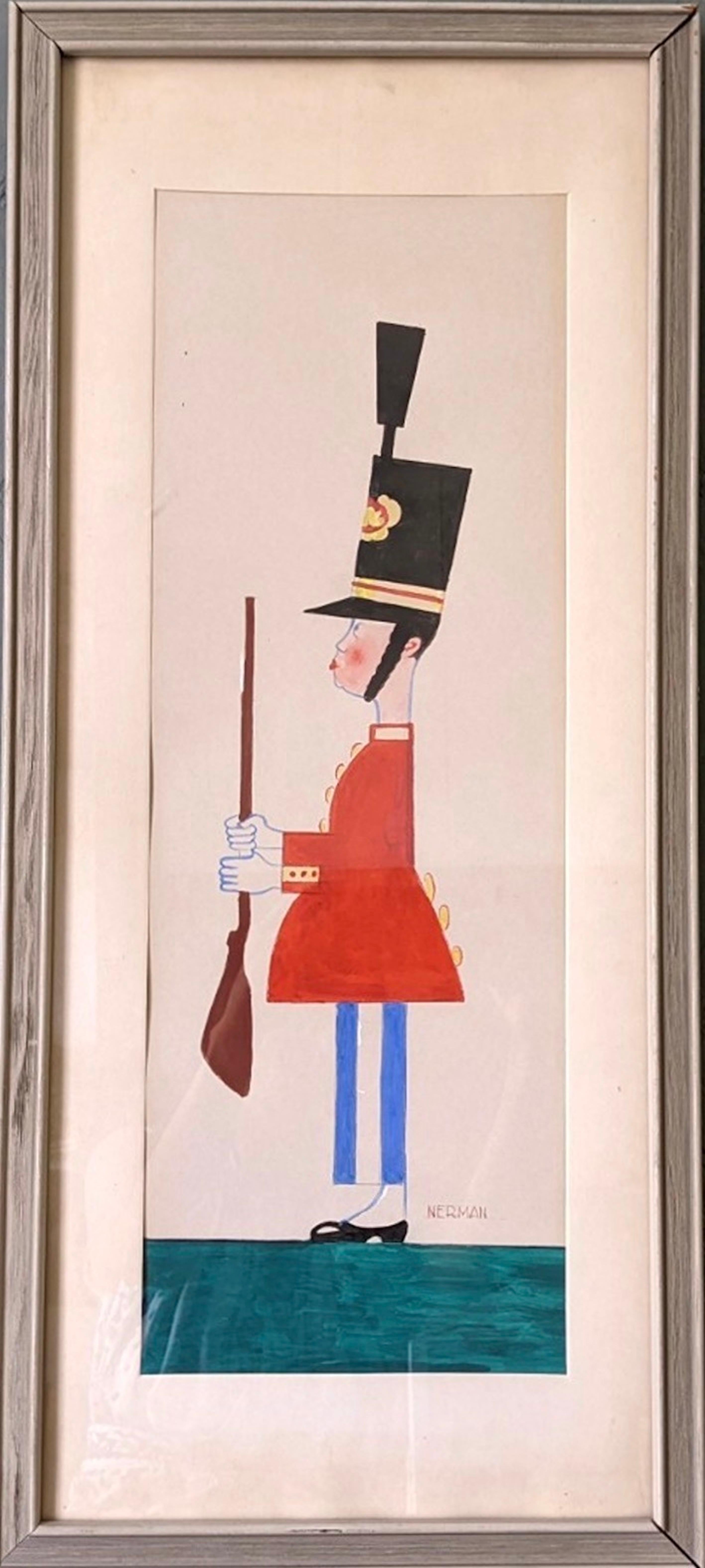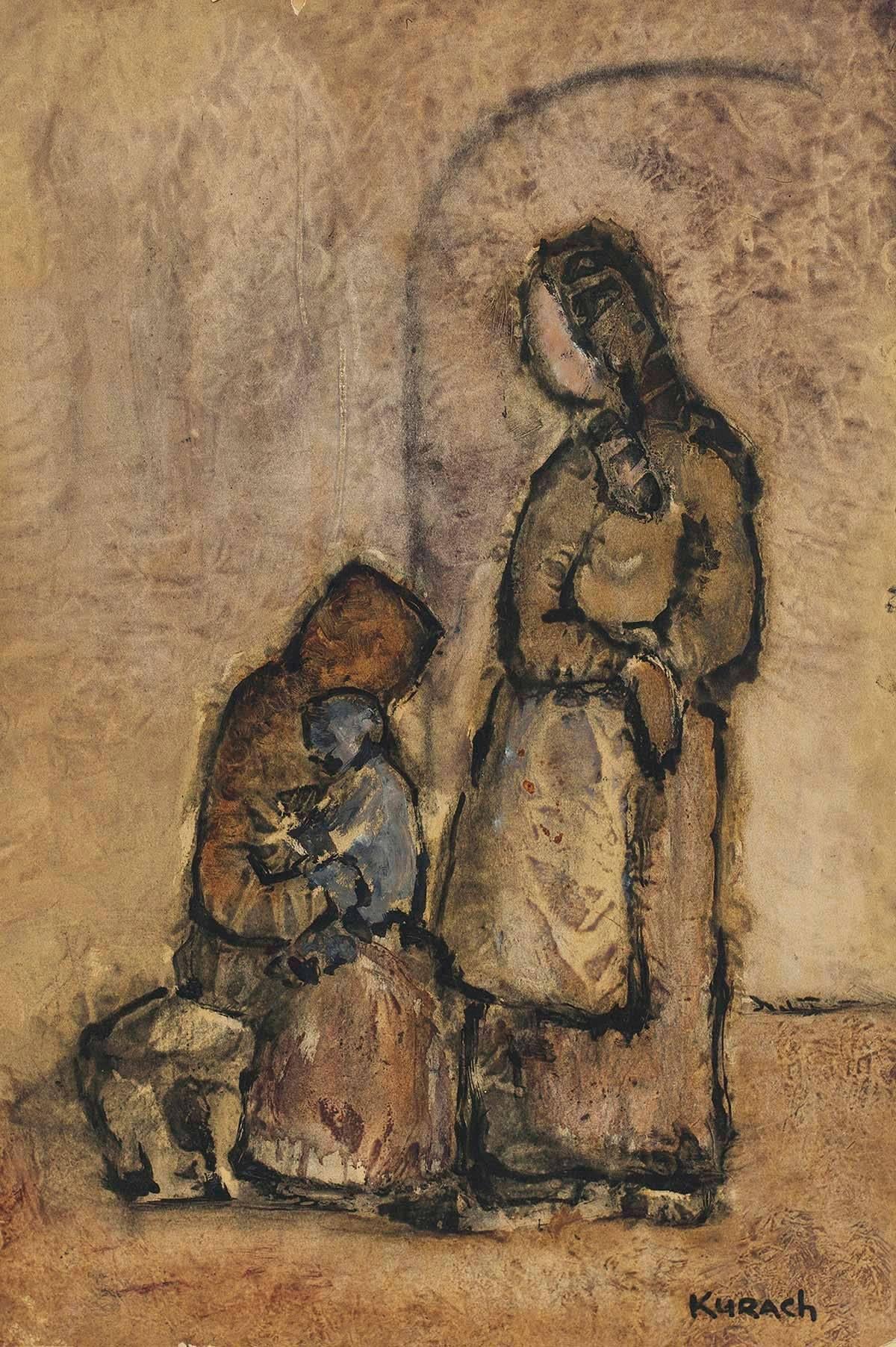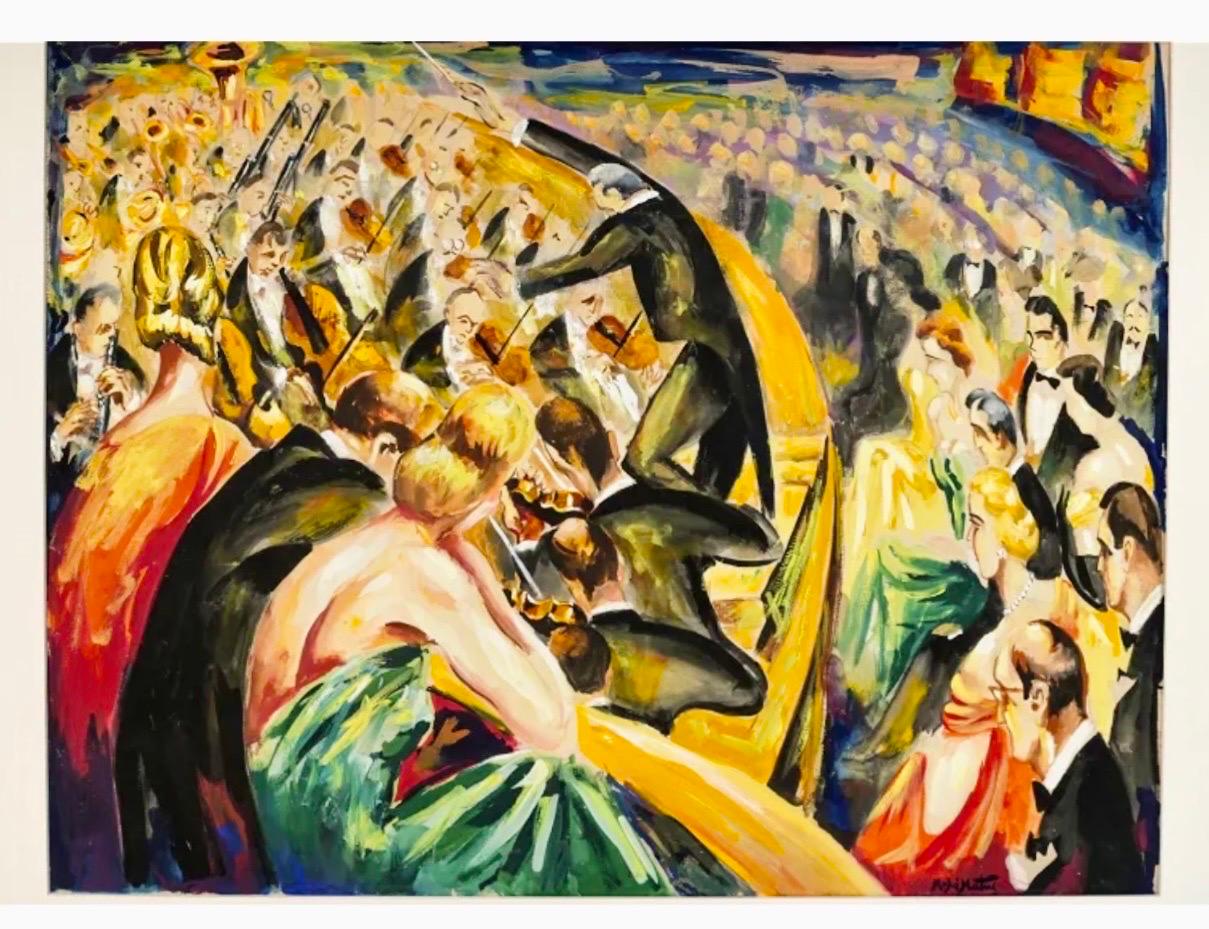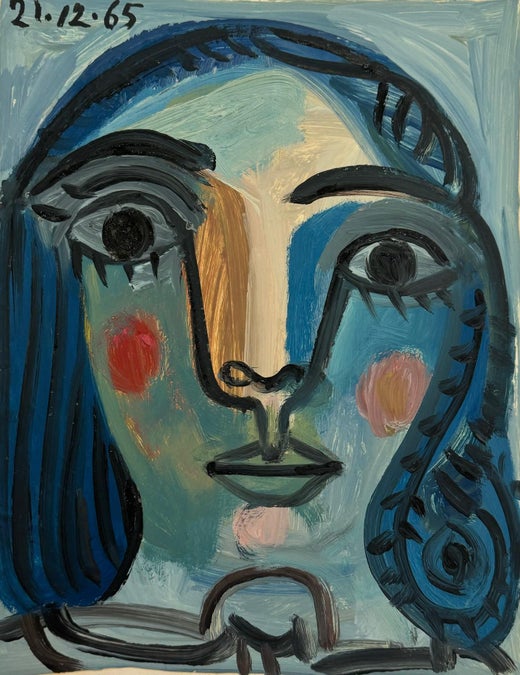Items Similar to Café de la Place
Want more images or videos?
Request additional images or videos from the seller
1 of 24
Raymond DebieveCafé de la Placecirca 1970s
circa 1970s
About the Item
'Café de la Place', gouache on paper, by Raymond Debiève (circa 1970s). A solitary stroller in a small French town crosses the street in front of a café along with his dog. With several tricolour flags fluttering in the breeze, the small Place gives the impression it is ready for a holiday celebration. The artist's naive style gives way to a work which is in reality, sophisticated, confident and blissful. Although Picasso's influence is undeniable in many of his works, Debiève's own naive artistic style is on display as well. In good overall condition. Newly framed and glazed with anti-reflective glass. On his unsigned works, the Debiève family certification authority affixes their stamp. In this case it appears in the lower right hand. Please enjoy the many photos accompanying this listing. A video may be provided upon request.
About the Artist: Raymond Debiève (1931-2011), was born, along with his twin brother, Michel, in the North of France near the border with Belgium. Their parents, of humble origins, noted a talent for drawing and art in both of the boys and encouraged them in that direction. Unfortunately the boys were separated during the war years but reunited afterwards. They attended the School of Fine Arts in Valenciennes after WWII where they were awarded successive 1st prizes in the Concours de Encouragement à l'Art. Raymond not only painted but was a gifted sculptor of metal works as well. In 1960 he exhibited, with great success, a series of very colourful paintings at the Galerie des Flandres in Lille, France and later in his career in Paris and Switzerland. Primarily with respect to his portraits of women, Raymond was undeniably influenced by Picasso. At the same time, he has managed to forge a distinct style which is much admired and now collected. In 1962, Debiève relocated to Provence with his family where he continued to create and exhibit art until his death in the town of Orange in 2011. Since then, Debiève's star has been on the rise and his works more and more in demand internationally.
Dimensions with frame:
H 77 cm / 30.3"
W 57 cm / 22.4"
Dimensions without frame:
H 61 cm / 24"
W 42 cm / 16.5"
- Creator:Raymond Debieve (1939 - 2011, French)
- Creation Year:circa 1970s
- Dimensions:Height: 30.32 in (77 cm)Width: 22.45 in (57 cm)
- Medium:
- Movement & Style:
- Period:
- Condition:
- Gallery Location:London, GB
- Reference Number:
Raymond Debieve
Raymond Debiève (1931-2011), was born, along with his twin brother, Michel, in the North of France near the border with Belgium. Their parents, of humble origins, noted a talent for drawing and art in both of the boys and encouraged them in that direction. Unfortunately the boys were separated during the war years but reunited afterwards. They attended the School of Fine Arts in Valenciennes after WWII where they were awarded successive 1st prizes in the Concours de Encouragement à l'Art. Raymond not only painted but was a gifted sculptor of metal works as well. In 1960 he exhibited, with great success, a series of very colourful paintings at the Galerie des Flandres in Lille, France and later in his career in Paris and Switzerland. Primarily with respect to his portraits of women, Raymond was undeniably influenced by Picasso. At the same time, he has managed to forge a distinct style which is much admired and now collected. In 1962, Debiève relocated to Provence with his family where he continued to create and exhibit art until his death in the town of Orange in 2011. Since then, Debiève's star has been on the rise and his works more and more in demand internationally.
About the Seller
5.0
Platinum Seller
These expertly vetted sellers are 1stDibs' most experienced sellers and are rated highest by our customers.
Established in 2016
1stDibs seller since 2017
439 sales on 1stDibs
Typical response time: <1 hour
- ShippingRetrieving quote...Ships From: London, United Kingdom
- Return PolicyA return for this item may be initiated within 7 days of delivery.
More From This SellerView All
- Chinatown, San FranciscoBy Edward Wilson CurrierLocated in London, GB'Chinatown, San Francisco', gouache on fine art paper, by Edward Wilson Currier (1903). Spofford Alley in San Francisco's Chinatown is best known for an address (number 36) where Dr. Sun Yat-Sen plotted the overthrow of China's last dynasty. During Prohibition, it was the site of turf battles over local bootlegging and protection rackets. Today it is lined with seniors' community centres. However, the quiet alley livens up in the evenings when a Chinese orchestra strikes up a tune, mah-jongg games begin with a cascade of clicking tiles, and barbers and florists use the pretence of sweeping their doorsteps to gossip. In this artist's depiction, a man smokes a long-stemmed Chinese pipe under the awning and colourful lanterns hanging from the wooden supports while a child looks on. The artwork is interesting from several standpoints including architectural, cultural and historical. Shortly after this work was painted, the neighbourhood was completely destroyed in the 1906 earthquake that levelled most of the city. From 1910 to 1940, Chinese immigrants were detained at the Angel Island...Category
Early 1900s Expressionist Figurative Drawings and Watercolors
MaterialsGouache, Paper
- Emile's TavernBy Lucien GéninLocated in London, GB'Emile's Tavern', gouache on paper (circa 1930s), by Lucien Génin. A tavern in French is called a 'guinguette'. With the rise in living standards from the 1860s along with the develo...Category
1930s Expressionist Figurative Paintings
MaterialsPaper, Gouache
- Church of Saint-Nicolas du Chardonnet in ParisBy Lucien GéninLocated in London, GB'The Church of Saint-Nicolas du Chardonnet, Paris', gouache on art paper by Lucien Génin (circa 1930s). In Paris' 5th Arrondissement the site in which Saint-Nicolas du Chardonnet is ...Category
1930s Expressionist Figurative Paintings
MaterialsPaper, Gouache
- Sacré-Coeur Montmartre at Willette Square ParisBy Lucien GéninLocated in London, GB'Sacré-Coeur, Montmartre at Willette Square, Paris', gouache on art paper (circa 1930s), by Lucien Génin. Created by the Director of Public Ways and Promenades under Napoleon III, Sq...Category
1930s Expressionist Figurative Paintings
MaterialsPaper, Gouache
- View of Saint-Médard Church ParisBy Lucien GéninLocated in London, GBA 'View of Saint-Médard Church, Paris', gouache on art paper, by Lucien Génin (circa 1930s). As viewed from the Rue Mouffetard, the church, which dates from the mid-1400s, continues ...Category
1930s Landscape Drawings and Watercolors
MaterialsGouache, Paper
- 'Cherry Blossoms in Japan', French SchoolLocated in London, GB'Cherry Blossoms in Japan', pencil, ink and gouache on card stock, French School (Mid 20th Century). Cherry blossoms (Sakura) symbolise springtime, a time of renewal and the fleeting...Category
Mid-20th Century Figurative Drawings and Watercolors
MaterialsInk, Gouache, Pencil
You May Also Like
- Suzanna and the EldersBy Ben ShahnLocated in Miami, FLA modern interpretation of the biblical story Suzanna and the Elders. Signed lower right Ink and wash on paper The Downtown Gallery Felix Landau Gallery Ernest Brown & Phillips, Ltd...Category
1940s American Modern Portrait Paintings
MaterialsWatercolor, Ink, Gouache, Archival Paper
- Vintage Mid-Century Modern Figurative Portrait Framed Painting, The Royal GuardLocated in Bristol, GBTHE ROYAL GUARD Size: 63 x 29 cm (including frame) Watercolor & Gouache on Paper A small yet impactful watercolour and gouache figurative composition of an upright figure of a royal...Category
1950s Modern Figurative Paintings
MaterialsPaper, Watercolor, Gouache
- Family of Three, Mid Century Gouache on PaperBy Ivan KurachLocated in Surfside, FLIvan Kurach (1909 – 1968) lived and studied in Italy. Well known both in Europe and in the United States, his paintings are found in famous private collections and in museums all ov...Category
Mid-20th Century Modern Figurative Paintings
MaterialsPaper, Gouache
- Large Tel Aviv Orchestra Israeli Bezalel School Modernist Painting Moshe MatusBy Moshe Matus (Matusovsky)Located in Surfside, FLMoshe (Matusovski) Matus (Polish Israeli , 1908-1958), Depicting an orchestral concert. Hand signed lower right. Dimensions: (Frame) H 31" x W 37", (Sight) H 21" x W 28" Moshe ...Category
1930s Modern Figurative Paintings
MaterialsPaper, Gouache
- Chicago Jewish Modernist Judaica Painting Simchat Torah WPA Artist Israeli FlagsBy Alexander Raymond KatzLocated in Surfside, FLThis has young ISraeli pioneers dancing with the flag as typical of works of the late British mandate Palestine era early state of Israel. Genre: Modern Subject: Figurative (stained glass style) Medium: Mixed media gouache on paper Hand signed lower left Alexander Raymond Katz, Hungarian / American (1895 – 1974) Alexander Raymond Katz was born in Kassa, Hungary, and came to the United States in 1909. He studied at the Art Institute of Chicago and the Chicago Academy of Fine Arts. In the late 1920s, he worked as a director of the Poster Department at Paramount Studios. He was appointed the Director of Posters for the Chicago Civic Opera in 1930. During the Great Depression, notable architect Frank Lloyd Wright urged Katz to become a muralist. In 1933, he was commissioned to paint a mural for the Century of Progress exposition in Chicago. In 1936, he painted the mural History of the Immigrant for the Madison, Ill., post office. Katz’s works were included in various exhibitions and now are part of several museum collections, including those of the Art Institute of Chicago; Corcoran Gallery of Art, Washington, D.C.; and the Jewish Museum, New York. His murals, bas-reliefs and stained glass designs adorn more than 200 Jewish synagogues in the United States. Katz and other Jewish artists in Chicago who expressed Jewish and Biblical themes were inspired by the artist Abel Pann (1883-1963). Pann, who is regarded as the leading painter of the Land of Israel, exhibited in the Art Institute of Chicago in 1920. Early in his career, Katz began to explore the artistic possibilities inherent in the characters of the Hebrew alphabet. He developed aesthetic and philosophical interpretations of each letter and became the leading innovator and pioneer in the field of Hebraic art. Katz applies this concept in the woodcut Moses and the Burning Bush. Hebrew letters appears in Moses’ head, his cane and inside the flame. The initial of Moses’ name crowns his head. The letter in the flame is the first letter of the name of God. A combination of images and Hebrew letters appeared commonly in illustrations of the scene Moses and the Burning Bush in the Haggadah, the book of Passover. The symbolism of the burning bush corresponds to the motifs of A Gift to Biro-Bidjan. Among the fourteen participating artists were notable Chicago modernists Todros Geller, Mitchell Siporin...Category
Mid-20th Century Modern Figurative Paintings
MaterialsPaper, Gouache
- Rare Modernist Hungarian Rabbi Pastel Drawing Gouache Painting Judaica Art DecoBy Hugó ScheiberLocated in Surfside, FLRabbi in the synagogue at prayer wearing tallit and tefillin. Hugó Scheiber (born 29 September 1873 in Budapest – died there 7 March 1950) was a Hungarian modernist painter. Hugo Scheiber was brought from Budapest to Vienna at the age of eight where his father worked as a sign painter for the Prater Theater. At fifteen, he returned with his family to Budapest and began working during the day to help support them and attending painting classes at the School of Design in the evening, where Henrik Papp was one of his teachers. He completed his studies in 1900. His work was at first in a post-Impressionistic style but from 1910 onward showed his increasing interest in German Expressionism and Futurism. This made it of little interest to the conservative Hungarian art establishment. However, in 1915 he met the great Italian avant-gardist Filippo Tommaso Marinetti and the two painters became close friends. Marinetti invited him to join the Futurist Movement. The uniquely modernist style that he developed was, however, closer to German Expressionism than to Futurism and eventually drifted toward an international art deco manner similar to Erté's. In 1919, he and his friend Béla Kádar held an exhibition at the Hevesy Salon in Vienna. It was a great success and at last caused the Budapest Art Museum to acquire some of Scheiber's drawings. Encouraged, Scheiber came back to live in Vienna in 1920. A turning point in Scheiber's career came a year later, when Herwarth Walden, founder of Germany's leading avant-garde periodical, Der Sturm, and of the Sturm Gallery in Berlin, became interested in Scheiber's work. Scheiber moved to Berlin in 1922, and his paintings soon appeared regularly in Walden's magazine and elsewhere. Exhibitions of his work followed in London, Rome, La Paz, and New York. Scheiber's move to Germany coincided with a significant exodus of Hungarian artists to Berlin, including Laszlo Moholy-Nagy and Sandor Bortnyik. There had been a major split in ideology among the Hungarian avant-garde. The Constructivist and leader of the Hungarian avantgarde, Lajos Kassák (painted by Hugó Scheiber in 1930) believed that art should relate to all the needs of contemporary humankind. Thus he refused to compromise the purity of his style to reflect the demands of either the ruling class or socialists and communists. The other camp believed that an artist should be a figurehead for social and political change. The fall out and factions that resulted from this politicisation resulted in most of the Hungarian avant gardists leaving Vienna for Berlin. Hungarian émigrés made up one of the largest minority groups in the German capital and the influx of their painters had a significant effect on Hungarian and international art. Another turning point of Scheiber's career came in 1926, with the New York exhibition of the Société Anonyme, organized by Katherine Dreier. Scheiber and other important avant garde artists from more than twenty-three countries were represented. In 1933, Scheiber was invited by Marinetti to participate in the great meeting of the Futurists held in Rome in late April 1933, Mostra Nazionale d’Arte Futurista where he was received with great enthusiasm. Gradually, the Hungarian artists began to return home, particularly with the rise of Nazism in Germany. Kádar went back from Berlin in about 1932 and Scheiber followed in 1934. He was then at the peak of his powers and had a special flair in depicting café and cabaret life in vivid colors, sturdily abstracted forms and spontaneous brush strokes. Scheiber depicted cosmopolitan modern life using stylized shapes and expressive colors. His preferred subjects were cabaret and street scenes, jazz musicians, flappers, and a series of self-portraits (usually with a cigar). his principal media being gouache and oil. He was a member of the prestigious New Society of Artists (KUT—Képzőművészek Új Társasága)and seems to have weathered Hungary's post–World War II transition to state-communism without difficulty. He continued to be well regarded, eventually even receiving the posthumous honor of having one of his images used for a Russian Soviet postage stamp (see image above). Hugó Scheiber died in Budapest in 1950. Paintings by Hugó Scheiber form part of permanent museum collections in Budapest (Hungarian National Museum), Pecs (Jannus Pannonius Museum), Vienna, New York, Bern and elsewhere. His work has also been shown in many important exhibitions, including: "The Nell Walden Collection," Kunsthaus Zürich (1945) "Collection of the Société Anonyme," Yale University Art Gallery, New Haven, Connecticut (1950) "Hugó Scheiber: A Commemorative Exhibition," Hungarian National Museum, Budapest (1964) "Ungarische Avantgarde," Galleria del Levante, Munich (1971) "Paris-Berlin 1900-1930," Centre Georges Pompidou, Paris (1978) "L’Art en Hongrie, 1905-1920," Musée d’Art et l’Industrie, Saint-Etienne (1980) "Ungarische Avantgarde in der Weimarer Republik," Marburg (1986) "Modernizmus," Eresz & Maklary Gallery, Budapest (2006) "Hugó Scheiber & Béla Kádár," Galerie le Minotaure, Paris and Tel Aviv (2007) Hugó Scheiber's paintings continue to be regularly sold at Sotheby's, Christie's, Gillen's Arts (London), Papillon Gallery (Los Angeles) and other auction houses. He was included in the exhibition The Art Of Modern Hungary 1931 and other exhibitions along with Vilmos Novak Aba, Count Julius Batthyany, Pal Bor, Bela Buky, Denes Csanky, Istvan Csok, Bela Czobel, Peter Di Gabor, Bela Ivanyi Grunwald, Baron Ferenc Hatvany, Lipot Herman, Odon Marffy, C. Pal Molnar...Category
Early 20th Century Modern Figurative Paintings
MaterialsPaper, Charcoal, Pastel, Watercolor, Gouache






